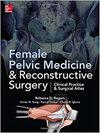Assessment of Level of Fear in Adult Patients Undergoing Elective Urogynecologic and Gynecologic Procedures and Surgeries During the COVID-19 Pandemic Using the Validated Surgical Fear Questionnaire
IF 1.4
4区 医学
Q3 OBSTETRICS & GYNECOLOGY
Female Pelvic Medicine and Reconstructive Surgery
Pub Date : 2022-02-23
DOI:10.1097/SPV.0000000000001162
引用次数: 2
Abstract
Objective This study aimed to assess and trend fears surrounding elective surgery and office procedures in benign gynecologic and urogynecologic patients during the coronavirus disease 2019 (COVID-19) pandemic. Methods This was a multicenter, prospective, observational study. Recruitment occurred from June 23, 2020, to March 23, 2021. Females 18 years or older presenting for elective benign gynecologic or urogynecologic surgery or office procedures were eligible. Patients were excluded if non-English speaking or undergoing an emergent procedure or surgery. Fear was assessed by the Surgical Fear Questionnaire (SFQ), which was also modified to include 2–4 additional questions pertaining to COVID-19 (modified version of the Surgical Fear Questionnaire [mSFQ]). Total SFQ scores and short- and long-term fear scores were compared between procedures and surgery and to historic data. Results A total of 209 patients undergoing 107 procedures or 102 surgical procedures completed the questionnaire. Participants were separated into subgroups determined by the timing of questionnaire completion related to phases of the pandemic. The most common procedure was urodynamics (n = 59 [55%]). The most common elective surgical procedure was hysterectomy (n = 59 [57.8%]). Furthermore, 72.5% of surgical procedures were for urogynecologic indications. Fear levels were low and not different in patients undergoing procedures versus surgery (12.38 ± 12.44 vs 12.03 ± 16.01, P = 0.958). There was no difference between procedures versus surgery for short- (6.21 ± 8.38 vs 6.81 ± 8.44, P = 0.726) or long-term fear (6.18 ± 8.89 vs 5.22 ± 8.20, P = 0.683). Compared with historic data, our hysterectomy patients had less surgical fear. The mSFQ demonstrated higher fear scores for both procedures and surgery (mSFQ, 20.57 ± 20.55 for procedures; 28.78 ± 28.51 for surgery). There were no significant fluctuations in SFQ score in relation to critical COVID-19 events. Conclusions Fear of surgery and office procedures was low and consistent throughout the COVID-19 pandemic and lower than historic data.使用有效手术恐惧问卷评估COVID-19大流行期间接受选择性泌尿妇科和妇科手术的成年患者的恐惧水平
目的本研究旨在评估2019冠状病毒病(新冠肺炎)大流行期间良性妇科和泌尿生殖系统患者对择期手术和办公程序的恐惧,并对其进行趋势分析。方法这是一项多中心、前瞻性、观察性研究。招聘时间为2020年6月23日至2021年3月23日。18岁或18岁以上的女性接受选择性妇科或泌尿生殖系统良性手术或办公室手术是合格的。如果患者不会说英语或正在接受紧急手术或手术,则将其排除在外。恐惧通过手术恐惧问卷(SFQ)进行评估,该问卷也进行了修改,包括2-4个与新冠肺炎有关的额外问题(手术恐惧问卷的修改版本[mSFQ])。将手术和手术之间的SFQ总分、短期和长期恐惧评分与历史数据进行比较。结果共有209例患者接受了107种手术或102种外科手术,完成了问卷调查。参与者被分为亚组,亚组由与疫情阶段相关的问卷完成时间决定。最常见的手术是尿动力学(n=59[55%])。最常见的选择性手术是子宫切除术(n=59[57.8%])。此外,72.5%的手术是针对泌尿生殖系统适应症。手术患者的恐惧水平较低,与手术患者没有差异(12.38±12.44 vs 12.03±16.01,P=0.958)。手术与手术患者的短期恐惧(6.21±8.38 vs 6.81±8.44,P=0.726)或长期恐惧(6.18±8.89 vs 5.22±8.20,P=0.683)没有差异。与历史数据相比,我们的子宫切除术患者的手术恐惧较少。mSFQ在手术和手术中都表现出更高的恐惧评分(mSFQ,手术为20.57±20.55;手术为28.78±28.51)。与新冠肺炎重大事件相关的SFQ评分没有显著波动。结论在整个新冠肺炎大流行期间,对手术和办公室程序的恐惧程度较低且一致,低于历史数据。
本文章由计算机程序翻译,如有差异,请以英文原文为准。
求助全文
约1分钟内获得全文
求助全文
来源期刊

Female Pelvic Medicine and Reconstructive Surgery
OBSTETRICS & GYNECOLOGY-
CiteScore
2.10
自引率
12.50%
发文量
228
期刊介绍:
Female Pelvic Medicine & Reconstructive Surgery, official journal of the American Urogynecologic Society, is a peer-reviewed, multidisciplinary journal dedicated to specialists, physicians and allied health professionals concerned with prevention, diagnosis and treatment of female pelvic floor disorders. The journal publishes original clinical research, basic science research, education, scientific advances, case reports, scientific reviews, editorials and letters to the editor.
 求助内容:
求助内容: 应助结果提醒方式:
应助结果提醒方式:


